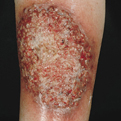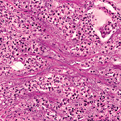Pyoderma Gangrenosum
General Information
Pyoderma Gangrenosum (PG) is an uncommon cause of ulcerations in the skin which may affect other organs. PG is classified into two types Classic or Atypical. Classic pyoderma gangrenosum consists of deep ulcerations with a purple border. The lesions often occur on the legs, but may occur anywhere on the body. Atypical pyoderma gangrenosum has more of a fluid filled component around the border. The lesions most often occur on the dorsa of the hands, the face or the extensor part of the forearms. There is no specific cause for PG, however skin trauma can result in new lesions on the skin pathergy. Treatment options include wound care with antibacterial ointments, corticosteroids to relieve inflammation or immunosuppresants.
Epidemiology
Occurs in 1 out of 100,000 people each year
Etiology
Unknown; Trauma to skin induces new lesions
Pathogenesis
Neutrophil dysfunction (i.e., defects in chemotaxis or hyperreactivity) has been suggested
Clinical
Classic – Deep ulceration with a violaceous border that overhangs the ulcer bed. Atypical – Has a vesiculopustular component. Usually only at the border, erosive or superficially ulcerateds
Histology
Massive neutrophilic infiltration, hemorrhage, and necrosis of the overlying epidermis
Bibliography
1. “Pyoderma Gangrenosum” (Online). September 2006. http://www.emedicine.com/derm/topic367.htm (visited: March 20, 2008) 2. “Pyoderma Gangrenosum” (Online). http://www.mayoclinic.org/pyoderma-gangrenosum(visited: March 20, 2008)
Download PDF
![]() Pyoderma Gangrenosum
Pyoderma Gangrenosum


